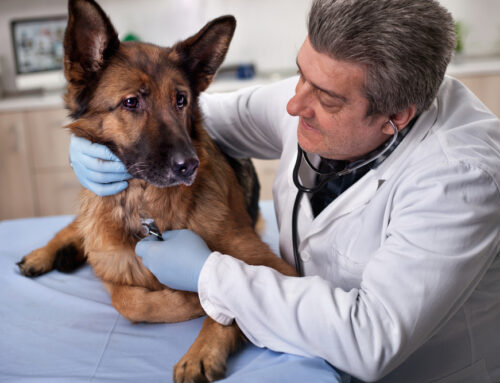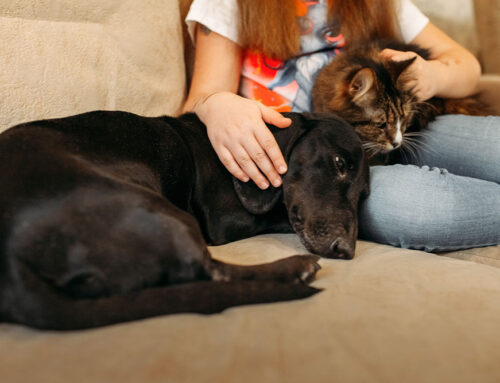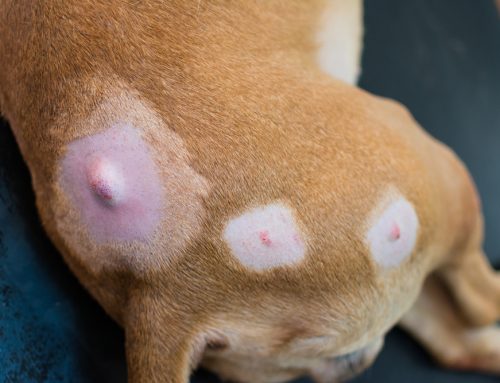The Veterinary Cancer Society estimates one in four dogs will develop cancer during their lifetime, and almost 50% of dogs older than age 10 will develop the disease. Fortunately, half of all canine cancers are treatable when diagnosed in the early stages. While cancer’s many early signs can be vague and nonspecific—and may indicate a less-invasive condition—your furry pal should have a veterinary examination if they exhibit any abnormal signs. Schedule an appointment with our Guam Pet Hospital team if your pet has any of the following 10 cancer signs.
#1: Your pet has a lump or bump beneath their skin
While not all cancer appears as a lump or bump beneath the skin, many types can cause visible masses. Some lumps are initially tiny and grow extremely slowly before becoming noticeable, whereas other masses seem to appear and grow rapidly overnight. Certain cancers can enlarge your pet’s lymph nodes, especially the lymph tissue behind their knees, at the front of their shoulders, and under their jaw. To help detect masses when they initially appear and are still small, regularly check for lumps on your pet by running your hands over their body. In addition, check inside your pet’s ears and mouth, and between their toes, as cancerous lumps can develop there.
#2: Your pet is emitting an abnormal odor
Many pet owners tease their furry pals about having doggy breath or other funky smells, but an abnormal, foul odor coming from your pet’s mouth, ears, or anus can signal cancer. Tumors can form in these unobtrusive areas, and you may believe your pet has no health issues until the cancer begins causing an unpleasant odor. Although an odor’s cause may not be cancer-related, you should still have your veterinarian perform an examinations, as your furry pal may have dental disease, an ear infection, or impacted anal glands in need of treatment.
#3: Your pet has a wound or sore that will not heal
A nonhealing wound can indicate drug-resistant bacteria—such as methicillin-resistant Staphylococcus aureus (MRSA)—are present, or that your pet’s immune system is not functioning properly. Sores that fail to heal can signal cancer, and some tumors ooze and bleed despite standard wound treatment.
#4: Your pet is losing weight or their appetite
Even when ill or in discomfort, many pets continue eating, so if your pet loses their appetite, you have cause to be seriously concerned. Some cancers can cause drastic weight reduction without appetite loss. If your pet is not on a diet but is losing weight, they could have cancer.

#5: Your pet is coughing or having difficulty breathing
If your pet has a persistent cough lasting longer than a few days, pants excessively—even when resting—or struggles to breathe normally, they have a serious health issue that your veterinarian needs to check out. Heart disease, laryngeal paralysis, and other respiratory disorders can cause breathing issues, but cancer that has spread to the lungs, or has developed as a primary tumor in the respiratory system, can also cause breathing difficulties.
#6: Your pet’s bathroom habits have changed
Any change in your pet’s urination or defecation habits can indicate a potentially serious cancer-related health concern. Tumors can form in the bladder, intestinal tract, or near the anus, preventing your pet from eliminating normally. Your pet may urinate and defecate more or less frequently, strain to eliminate, develop constipation or diarrhea, or have bloody urine or stool.
#7: Your pet is having difficulty eating or swallowing
Oral melanomas in dogs and squamous cell carcinomas in cats are two relatively common mouth tumors that can cause eating and swallowing problems. Because looking in your pet’s mouth is not always easy, you may not spot an oral tumor before the growth begins to cause issues.
#8: Your pet has unexplained bleeding or discharge
Cancerous processes often cause unexplained bleeding or discharge from pets’ body openings, such as the mouth or anus. A tumor near a pet’s body opening, or a cancerous process occurring deep inside the body may be causing unexplained bleeding or discharge.
#9: Your pet is lame or moves stiffly
Some cancers—especially bone cancer—are extremely painful, and can cause your pet to limp or appear lame. If your pet has a lump on one of their limbs and they begin limping, your beloved companion may have osteosarcoma.
#10: Your pet is lethargic or less active
Cancer’s first sign could appear as simply as a decrease in your pet’s activity. Your furry pal may be lethargic, and become disinterested in their favorite activities.
If your pet has any cancer signs, do not wait for the condition to resolve without treatment. Early diagnosis gives your pet a fighting chance against cancer, so immediately contact our Guam Pet Hospital team for an appointment.








Leave A Comment